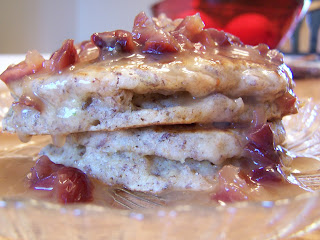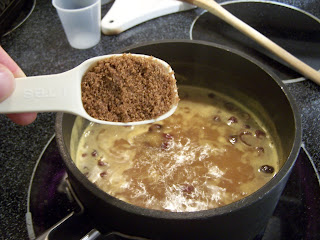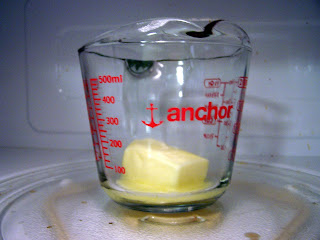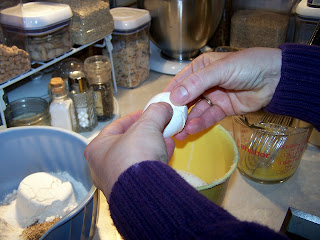A few days after the New Year, I announced I was making pancakes for dinner. Normally, this comes as welcome news to the fam since we LOVE breakfast for dinner. Real maple syrup and melting butter sliding down hot pancakes, doesn't it make you drool? But this time, Matt groaned and said, "Pancakes are expensive!"
Now, it really isn't the pancakes themselves that are so "expensive" or high in calories. It is the syrup. A 1/4 cup serving of syrup is 200 calories!!!! And who sticks to that teeny-tiny 1/4 c. over a meal of pancakes???? So I got to thinking about what I could do to improve my pancake recipe and lower the calories. The classic combination of cranberries and oranges was fresh on my mind after Christmas, so I decided to replace the typical calorie laden maple syrup with an orange juice based syrup.
I took my knowledge of my cranberry compote and applied it in a little different direction. Since this needed to be a year-round meal, I stayed away from fresh cranberries which might be hard to find in summer. Dried sweetened cranberries seemed to be the logical choice. I cooked them in some orange juice, a little brown sugar and cinnamon then thickened it with some cornstarch. SUCCESS! Not only was it delicious, it was much lower in calories than maple syrup. It only has 59 calories per 1/4 cup instead of a whopping 200.
The pancakes the syrup was served on were heavily influenced by The Joy of Cooking and Alton Brown's pancakes. Basically, I increased the fiber by adding milled flax seed and subbing half of the all-purpose flour with whole wheat flour.
Cran-Orange Syrup:
1 3/4 c. orange juice plus 2 T. orange juice, divided
1/4 c. water
1/2 c. dried cranberries, roughly chopped
2 t. brown sugar
1/8 t. cinnamon
pinch of salt
1 T. cornstarch
In a small saucepan, combine cranberries and orange juice.
Bring to a boil, then add the cinnamon and brown sugar.
Lower the heat and let it simmer. During this time, the cranberries will be reconstituting. In a small mixing bowl, combine cornstarch and reserved orange juice with a whisk. This is called a slurry.
Next step is to pour the slurry into the saucepan. It will slowly thicken as it simmers. Just keep it on low heat while you make the pancakes.
High-Fiber Buttermilk Pancakes:
1 c. all-purpose flour
1 c. whole wheat flour
1/2 c. milled flax seed
2 t. sugar
1 1/2 t. baking powder
1 t. baking soda
1 t. salt
2 eggs
2 c. buttermilk (or more if you want a thinner batter)
1/4 c. melted butter
In a large mixing bowl, combine both flours, flax seed, sugar, baking powder, baking soda and salt.
Mix well. Now turn your attention to the wet ingredients. I follow Alton Brown's way of combining the wet ingredients. First, melt the butter. I use a small 1 c. Pyrex measuring cup.
Then, measure out your buttermilk in a medium bowl. Now, it is time to separate eggs. What? Separate eggs you say? Why? I first saw Alton Brown do this and it makes a lot of sense to me. He puts the egg yolk and butter together then whisks the buttermilk and egg whites together. I like this because when you add the yolk to the warm butter it prevents all the butter from clumping back up when it is added to the colder buttermilk. So, separate your eggs...putting the yolks in the butter and the whites in the buttermilk. Here is the way I separate eggs. First, I crack the egg and hold it over the container that will be receiving the egg white. I gently pull apart the egg shell and pull my right hand under to catch the yolk in one half of the egg shell. Most of the white will drop, then I gently toss the egg back and forth in each part of the egg shell until all the white is separated.
 |
| Thanks to my daughter, Emma for taking pics for me! |
Then, I put the egg yolk in the butter.
Repeat with the other egg. Now, whisk both the yolk and butter together. Do the same with the buttermilk and egg whites. Add the egg yolk/butter to the buttermilk/egg whites. (NOTE: I prefer my batter thick. If you like your batter thinner, add 1/2 c. of buttermilk at this time.)
Mix these well. Preheat your griddle to 350 degrees. If you are using a regular frying pan, heat your pan over medium high heat until butter dropped on it sizzles immediately but doesn't turn brown right away. If the butter melts slowly, it isn't hot enough; if the butter almost immediately turns brown, it is too hot.
It is time to add your wet ingredients to the dry. Do this quickly and DO NOT over mix. If you do, your pancakes will be tough. It is okay to leave a few dry patches...they will cook out.
If your pan/griddle is hot it is time to scoop 1/4 cupfuls onto it. Since I like my batter thicker it requires me to spread out the batter with the top of my 1/4 c. to flatten it.
Cooking pancakes can be tricky. When do you flip them? I know mine are ready to flip when the edges no longer look wet. They will be dull and the tops of the pancakes will have bubbles on them.
This one is almost ready to flip. I also check underneath with a spatula to see if a deep golden brown color has been achieved. After flipping you will know when they are done when the sides of the pancake look dry.
 |
| Not quite ready..... |
 |
| Now it is ready!!! |
For one pancake: 144 calories, 6.4 g. fat, 3.6 g. fiber














No comments:
Post a Comment